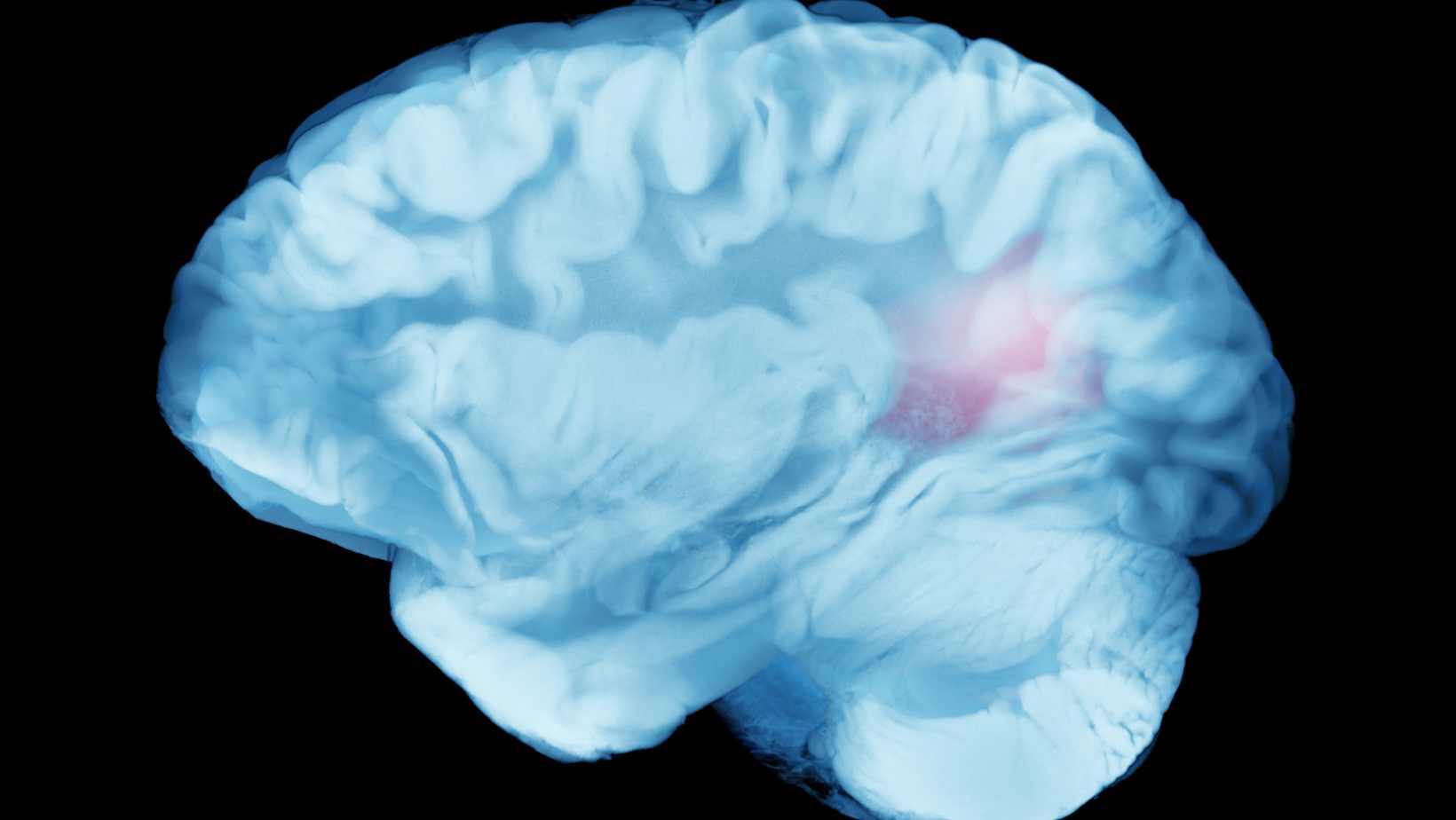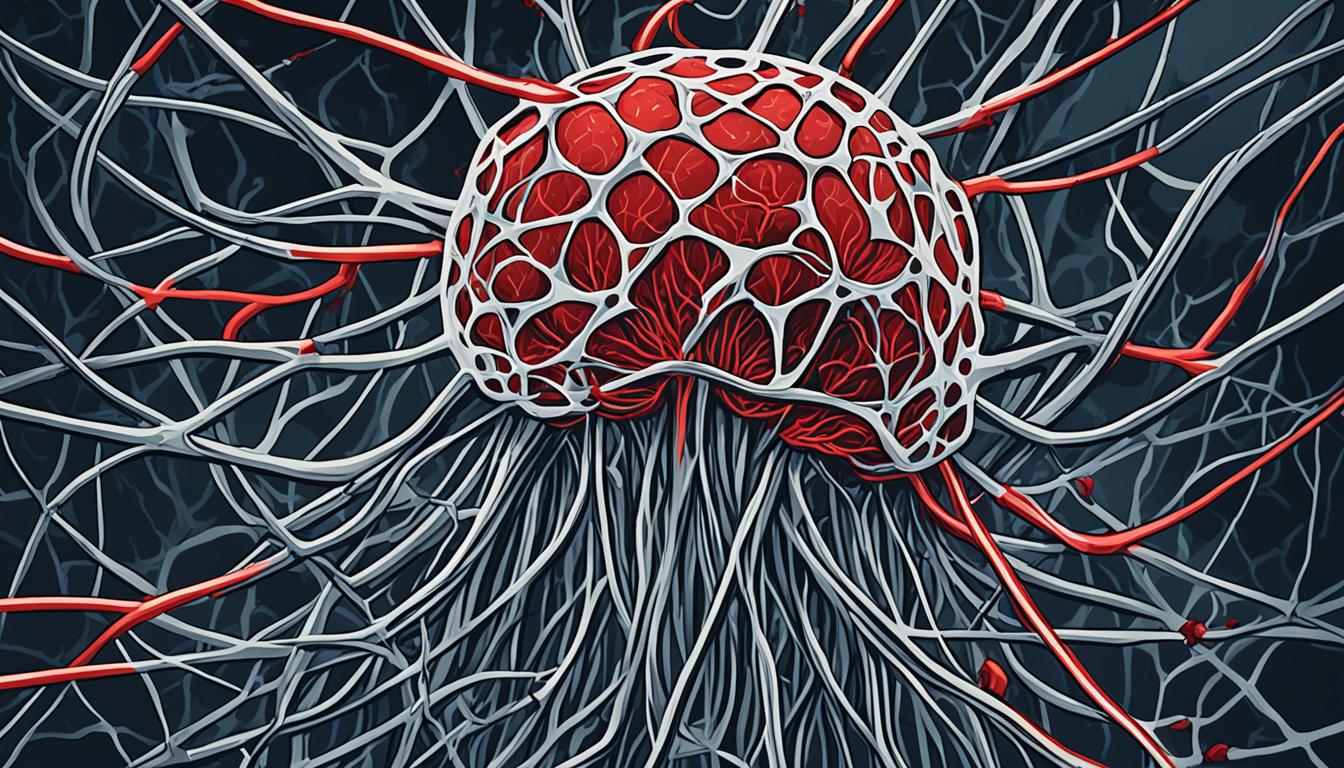Neuromyelitis optica spectrum disorder (NMOSD) is a rare autoimmune condition. It mainly affects the optic nerves and spinal cord. It was once thought to be a type of multiple sclerosis. Now, it’s seen as a unique disease with different features. This guide will cover what we know, the symptoms, treatment, and how to manage NMOSD.
The global cases of neuromyelitis optica spectrum disorders vary. It goes from 0.3 to 4.4 per 100,000. NMOSD affects more females (80%) than males. Most cases show up in people between 30 and 40 years old. Rarely, kids get NMOSD, making up less than 5% of cases. Some insights find that people of African descent with NMOSD might be older. They tend to have more lesions on their MRI scans. They also might have more frequent relapses than other groups.
Table of Contents
ToggleUnderstanding Neuromyelitis Optica Spectrum Disorder
Neuromyelitis optica spectrum disorder (NMOSD) is a rare autoimmune condition. It differs from multiple sclerosis (MS). This is because, in the 2000s, scientists found the aquaporin-4 (AQP4) antibody. This discovery showed that NMOSD is its own unique disease.
Definition and Diagnostic Criteria
In 2015, new diagnostic criteria for NMOSD were set. These criteria help doctors know if a person’s inflammatory lesions are from NMOSD. They are also important for telling NMOSD apart from other diseases like MS.
Pathophysiology and Aquaporin-4 Antibodies
The cause of NMOSD is due to autoantibodies attacking the AQP4 water channel. This channel is found a lot in the brain and spinal cord. The attacks lead to the inflamed areas characteristic of NMOSD.
Epidemiology and Risk Factors
Neuromyelitis Optica Spectrum Disorder (NMOSD) is a rare autoimmune disease. It affects 0.5-10 people in every 100,000. Such cases vary by region, with more found in some places.
Prevalence and Incidence
More women get NMOSD than men. For every 9 female cases, there’s only 1 male case. It usually first appears when people are in their 30s to 50s.
Pediatric cases are not common, making up under 5%. It’s essential for doctors to know about this since children may show different symptoms.
Demographic and Clinical Features
Worldwide, NMOSD makes up 1-2% of demyelinating diseases, similar in the US and Italy. Yet, this figure soars to over 30% in Thailand. If someone of African descent gets NMOSD, they might have more recurring issues and a later start of symptoms.
Genetic and Environmental Factors
NMOSD has links to other autoimmune conditions like systemic lupus erythematosus. After certain triggers, such as an infection or a vaccination, the disorder might show up in 20-30% of people.

Clinical Manifestations
Neuromyelitis optica spectrum disorder (NMOSD) shows up as severe episodes. These hit the optic nerves, spinal cord, and brain hard. The results can be devastating, greatly lowering the patient’s quality of life.
Optic Neuritis
Optic neuritis is a common sign of NMOSD. It causes loss of vision in one or both eyes. This loss can be very severe and may become permanent. This is more likely in NMOSD than in other similar diseases.
Transverse Myelitis
Transverse myelitis causes sudden and severe weakness and feeling changes in the arms and legs. It’s a key feature of NMOSD. This can lead to many problems, from paralysis to issues with bladder and bowel control.
Brain Stem and Diencephalic Manifestations
NMOSD isn’t just about the eyes and spinal cord. It can also affect the brain stem and the diencephalon. Brain stem issues can cause constant hiccups, nausea, vomiting, and trouble breathing. Some research also links NMOSD to narcolepsy.
Diagnosis and Differential Diagnosis
Finding out if someone has NMOSD involves looking at their symptoms, test results, and pictures of their body, called imaging. A key test looks for AQP4 antibodies. These help doctors tell NMOSD apart from MS and other illnesses.
MRI Findings
In NMOSD, MRI scans often show long spots in the spinal cord, spanning three or more segments. These spots are usually in the middle of the spinal cord, in the gray matter. The brain’s MRI can show lesions near certain brain parts and a special zone in the medulla.
Laboratory Tests
Finding AQP4 antibodies in the blood is a key difference between NMOSD and MS. But, some NMOSD patients are still diagnosed without these antibodies, if their symptoms fit the disease.
Myelin Oligodendrocyte Glycoprotein (MOG) Antibodies
A new finding is another antibody, called MOG, linked to a condition named MOGAD. This finding broadens the disorders related to NMOSD. It stresses the importance of thorough diagnostic and care strategies.

Neuromyelitis Optica Spectrum Disorder Treatment
The approach to treating neuromyelitis optica spectrum disorder (NMOSD) is broad. It aims to handle both immediate and ongoing control. Knowing the available treatments enables doctors to give the best care for this rare autoimmune disease.
Acute Relapse Management
During acute relapses, doctors often use high-dose corticosteroids first. But if they don’t work well, other options like plasma exchange or intravenous immunoglobulin might be tried. These help limit the damage and stop further harm.
Disease-Modifying Therapies
For the long term, therapies that change the disease’s course are vital. They lower the chance of future attacks and better the patient’s outlook. Drugs like Eculizumab, Satralizumab, and Inebilizumab show they can reduce relapses. Rituximab is also effective, though it’s not officially approved for NMOSD. Medications that suppress the immune system, such as azathioprine, mycophenolate, and methotrexate, may also form part of the treatment.
Emerging Therapies
Research is rapidly introducing new NMOSD treatments. For instance, scientists are looking into blood markers like GFAP and serum neurofilament light chain. These may help detect and watch for relapses. Also, intravenous immunoglobulins appear to lower neuromyelitis optica’s relapse rate.
Dealing with NMOSD fully needs teamwork among health professionals, patients, and their support systems. Knowledge of treatment options and keeping up with new developments are crucial. This way, people with NMOSD get the best, most personalized care.
Prognosis and Monitoring
The outlook for neuromyelitis optica spectrum disorder (NMOSD) varies, but it can be very serious. People with NMOSD are at a high risk of having lasting nerve damage. This can happen if relapses are not treated quickly and well.is essential for spotting and dealing with relapses early. It also helps check if the treatment is working.
New treatments have helped, but NMOSD can come back in more than 90% of cases. Till recently, about half of NMOSD patients needed a wheelchair or became blind within 5 years of getting the disease.
Being careful and keeping an eye on things is key to avoiding serious problems. Your medical team will look at your symptoms, eyesight, movement, and other nerve-related signs often. This is to catch any new signs of the disease fast. Regular MRIs and lab tests are also crucial to understand how the disease is changing. These help doctors choose the best treatments and see how well you’re doing.
Staying closely connected with your doctors and following their advice for regular check-ups is very important. This partnership is vital for how well you’ll do in the long run. Regular checks and watching out for any new problems can save your nerve health and keep your life quality high.

Neuromyelitis Optica Spectrum Disorder and Quality of Life
Impact on Activities of Daily Living
Neuromyelitis Optica Spectrum Disorder (NMOSD) may heavily affect a person’s life quality. It brings physical, emotional, and mental challenges. Vision loss and trouble moving reduce a patient’s independence, making them rely more on others.
Emotional and Psychological Well-being
NMOSD can lead to emotional problems like depression and anxiety. Sleep issues are also common. Around 44.3% might feel depressed, while anxiety and sleep problems affect 45% and 55% of patients.
Health-Related Quality of Life Measures
The impact on a patient’s health-related quality of life is well-studied. Tests show that NMOSD affects both physical health and mental well-being. Symptoms like pain and fatigue, along with difficulties at work, lower the quality of life for these patients.
Ongoing Research and Future Directions
The NMOSD research field is quickly growing. Scientists are trying to understand the disease more, make better tools for diagnosing it, and create treatments that work better. They’re looking at different antibodies, like MOG, to see what role they play in the disease. They’re also studying if certain genes or the environment make someone more likely to get NMOSD.
Just how common NMOSD is and where it shows up is another focus. Recent studies shed light on how often it occurs and where, helping doctors better diagnose and treat it.
Scientists are also studying the disease’s building blocks. They’re looking closely at autoantibodies, especially ones against aquaporin-4 and MOG, to piece together the disease’s process. New research, like Teles and team’s in 2021, is showing us more about how these antibodies work. This might lead to treatments that target them.
Better ways to diagnose NMOSD are also being sought. Researchers are checking if different lab tests, like looking for specific autoantibodies, can help spot the disease sooner and more accurately.
There’s a lot happening in testing and studying therapies, thanks to clinical trials and reviews. These include work by Siritho and colleagues published in 2021. They’re testing both new and old treatments for NMOSD. Looking into treatments that act on IL-6 and aquaporin-4 shows promise. Tests on using plasma exchange and stem cell transplants are happening too.
Researchers are not just looking at the disease itself but also at its effects on life quality. They want to see how to give NMOSD patients better care. By meeting all needs of NMOSD patients, health providers hope to make their lives better and their conditions easier to manage.

Neuromyelitis Optica Spectrum Disorder Patient Education
Support Groups and Resources
It’s crucial to teach NMOSD patients and caregivers about the disease. This knowledge helps manage the disease better. It also improves their quality of life. Patients need to know about NMOSD – its symptoms, treatments, and where to get support.
The NMOSD Support Group is a great resource. It lets patients and families connect and share their stories. They can get helpful info from meetings and online discussions. This support group offers a way to deal with NMOSD’s challenges together.
Also, patients should use top online resources, like the National Institutes of Health (NIH) site. These sites give details about NMOSD, its diagnosis, and treatment. Doctors can show patients these sites. This way, patients can get the info they need to handle their condition well.
Knowing about NMOSD and joining a support group can make a big difference. It helps patients live better with this autoimmune disorder. Healthcare professionals play a key part in linking patients to this support and knowledge.
Conclusion
Neuromyelitis optica spectrum disorder (NMOSD) is a rare condition that’s caused by the body attacking its own cells. It needs a detailed, team-based management plan. This involves knowing the disease’s characteristics, symptoms, how to diagnose it, and the best treatments.
This article has shown NMOSD can have various symptoms and effects on the body’s immune system. It’s key to diagnose it early and act fast. Also, having other autoimmune diseases with NMOSD can change how we manage it. That highlights the value of treating the whole patient, not just the NMOSD.
Staying updated through research and educating patients are vital for making things better for those with NMOSD. The field of NMOSD is always learning more, so healthcare professionals need to keep up. This way, they can offer the best treatments based on new evidence to their patients.
FAQ
What is neuromyelitis optica spectrum disorder (NMOSD)?
NMOSD is a rare, autoimmune disease. It mainly affects the optic nerves and the spinal cord. It was once thought to be a type of multiple sclerosis. But now we know it’s different, with its own features.
What are the key symptoms of NMOSD?
NMOSD shows up as sudden, serious attacks. These attacks affect the optic nerves, spinal cord, and brain. Some major signs include vision loss in one or both eyes and weakness in the limbs.
How is NMOSD diagnosed?
To diagnose NMOSD, doctors look at various factors. This includes symptoms, results from MRIs, and blood tests for AQP4 antibodies. MRIs might show specific brain and spinal cord lesions.
How is NMOSD treated?
NMOSD treatment is complex, targeting both short-term and long-term needs. During acute attacks, the first treatment is often high-dose steroids. Long-term, there are specific therapies to manage the disease.
What is the prognosis for individuals with NMOSD?
The outlook for NMOSD varies. It can lead to major, lasting effects if not treated quickly. Regular check-ups and appropriate treatments are key to managing the disease.
How does NMOSD impact a patient’s quality of life?
NMOSD affects more than just the body. It also touches the mind and emotions. The condition’s impact on vision and ability to move can significantly reduce independence.
What are the latest developments in NMOSD research?
NMOSD research is moving fast. Scientists are looking into new antibodies and searching for genetic and environmental causes. The goal is to better understand and treat NMOSD.
Source Links
- https://www.ncbi.nlm.nih.gov/pmc/articles/PMC6454358/
- https://www.ncbi.nlm.nih.gov/books/NBK572108/
- https://www.sumairafoundation.org/wp-content/uploads/2022/01/MS_NMOSD_Guide_EN.pdf
- https://www.mayoclinic.org/diseases-conditions/neuromyelitis-optica/symptoms-causes/syc-20375652
- https://www.ncbi.nlm.nih.gov/pmc/articles/PMC7332882/
- https://jnnp.bmj.com/content/89/6/555
- https://www.neurologylive.com/view/differential-diagnosis-and-types-of-nmosd
- https://www.ncbi.nlm.nih.gov/pmc/articles/PMC5476332/
- https://www.mayoclinic.org/diseases-conditions/neuromyelitis-optica/diagnosis-treatment/drc-20375655
- https://www.ncbi.nlm.nih.gov/pmc/articles/PMC8395403/
- https://wearesrna.org/living-with-myelitis/disease-information/neuromyelitis-optica-spectrum-disorder/prognosis-management/
- https://www.ncbi.nlm.nih.gov/pmc/articles/PMC9075919/
- https://www.sciencedirect.com/science/article/abs/pii/S2211034822000153
- https://www.frontiersin.org/journals/neurology/articles/10.3389/fneur.2023.1099376/full
- https://www.ncbi.nlm.nih.gov/pmc/articles/PMC10373306/
- https://www.ncbi.nlm.nih.gov/pmc/articles/PMC7998461/
- https://www.ncbi.nlm.nih.gov/pmc/articles/PMC8464318/
- https://www.ncbi.nlm.nih.gov/pmc/articles/PMC4481785/
- https://bmcneurol.biomedcentral.com/articles/10.1186/s12883-014-0162-7

Dr Chandril Chugh
Dr. Chandril Chugh, a renowned American Board-Certified Neurologist, is just a click away. With years of global experience, he offers trusted neurological guidance online.
→ Book a consultation to discover which remedies suit your needs best.




